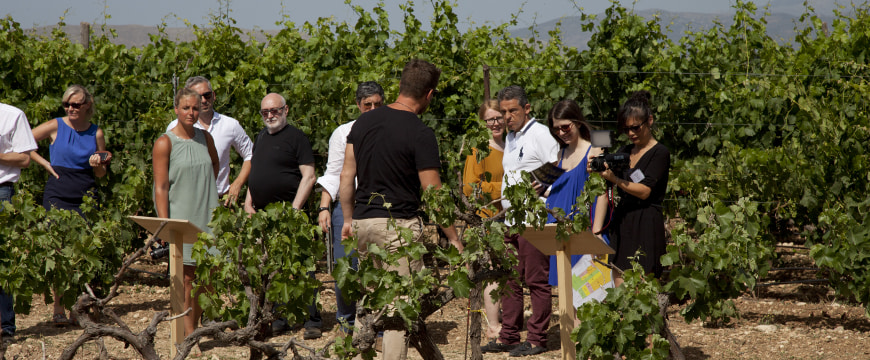This year, the TUI Care Foundation began working with Greeks to help support sustainable tourism in Crete by bringing together the island’s tourism and agriculture sectors. At the same time, the Association of Cretan Olive Municipalities continued its ongoing efforts to promote agrotourism activities focused on olive trees and olive oil in Crete.
The TUI Care Foundation has joined forces with the Local Food Experts, Futouris, the Greek Ministry of Tourism, and the regional government of Crete in “an extensive project for sustainable food and ecological agriculture on Crete” that seeks to support “long-term improvement in the quality of food” offered to tourists while strengthening the local economy. To do so, they link “the island's most important economic factors – tourism and agriculture,” according to the TUI Care Foundation’s website.
Focusing on “the two main products of Crete – wine and olive oil” -- and their environmentally friendly production, the project already includes more than 80 local wine growers and olive farmers as well as numerous hotel partners. It supports the production of local wines from less-known grape varieties and is developing “an innovative and interactive excursion program” to allow visitors direct contact with wine and olive oil producers at local production sites where tourists can learn about the products.
As Thomas Ellerbeck, Chairman of the Board of Trustees of the TUI Care Foundation, explained, the project in Crete “shows how great the potential of tourism is for local value creation and employment in the holiday country. In order that everyone benefits from this – guests, local businesses, and the local population – a close networking of the economy, agriculture, and the tourism sector is important. We need to develop a common understanding of what guests value when visiting a holiday destination. And in the tourism industry we need to promote the fact that we are open to local products, influences, and experiences."
A closer link between tourism and agriculture in Crete has long been advocated by local individuals and organizations such as the Association of Cretan Olive Municipalities (ACOM, or SEDIK, in Greek). In a recent article with a title that translates as “Olive tourism! The key to linking agriculture and tourism in Crete,” ACOM’s scientific consultant, Dr. Nikos Michelakis, explains that ACOM has helped promote more than 50 olive-related attractions in Crete that can draw visitors to the island’s scenic interior: various monumental olive trees, which ACOM has identified on a map on its website, as well as olive oil museums, mills, and bottling plants, archaeological monuments related to olive oil, and restaurants featuring traditional Cretan dishes made with locally produced olive oil.
Michelakis reports that ACOM’s efforts to promote agrotourism activities focused on olive trees and olive oil in Crete have born fruit. For example, more than 8,000 tourists visited the monumental olive tree of Vouves in July alone. Most came on a guided bus tour that also included the olive museum next to the ancient tree, free illustrated books about olive oil published by ACOM and the International Olive Council, and visits to another monumental tree, a restaurant in the midst of olive groves, and Anoskeli olive mill and winery, which offers guided tours and tasting sessions.
Michelakis explains that local mayors have helped promote the monumental olive tree of Vouves and the adjacent museum as a pioneering Cretan agrotourism destination – the kind ACOM has been advocating for years. Attracting growing numbers of visitors in recent years (20,000 or more, annually), the Vouves tree is a fitting centerpiece for Cretan tourism, not only because locals believe it to be the oldest olive tree in the world, but also due to its beautiful sculptural qualities and its cultural significance as the source of wreaths for Olympic champions starting in 2004.
In a second article, Michelakis advocates the development of additional olive routes in other parts of Crete and offers some suggestions (many visible on ACOM’s helpful online map, with several also discussed and mapped on the Cretan Beaches website). In the following paragraphs, I summarize Michelakis’s recommendations and add additional links to more information for tourists.
In the Chania prefecture, Michelakis suggests tourists visit the Olive Museum of Vatolakkos and the ancient olive tree near it. In the Apokoronas area, he proposes the monumental olive tree of Samonas, the Byzantine olive press at the Monastery of Agios Georgios (Saint George), and the pre-industrial olive press of Gavalochori.
In the prefecture of Rethymno, Michelakis recommends a route including the Prinaris Mill museum and the ancient olive tree in Chromonastiri, as well as a visit to the monumental olive trees of Amari and the Olive Museum of Panakron, which can be accompanied by stops at olive presses and restaurants featuring olive oil.
In the prefecture of Heraklion (Iraklio), Michelakis proposes routes featuring the monumental olive trees of Kamilari, Gortina (or Gortyna, or Gortyn), and Panasos and the olive mill at the Odigitria Monastery, as well as nearby olive mills such as Protogerakis in Vori, which welcomes visitors. Michelakis also recommends the areas of Malevizi and Hersonissos for their olive mills and museums (such as the Lychnostatis Open Air Museum).
In Lasithi, eastern Crete, itineraries can include the Agricultural Cooperative of Kritsa and the monumental olive tree of Kavousi (Azoria) – another grand old tree which locals believe to be the oldest in the world -- and the Mathena (or Mathaina) olive tree in Lastros, as well as the facilities of the Toplou Monastery, where award-winning extra virgin olive oil and wine are produced, and the Agricultural Cooperative of Kato Zakros in Sitia.
_____________
Thanks to the TUI Care Foundation for the photo of the Lyrarakis Winery’s vineyards.


